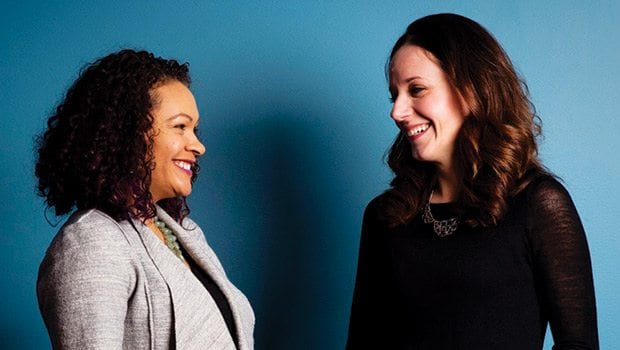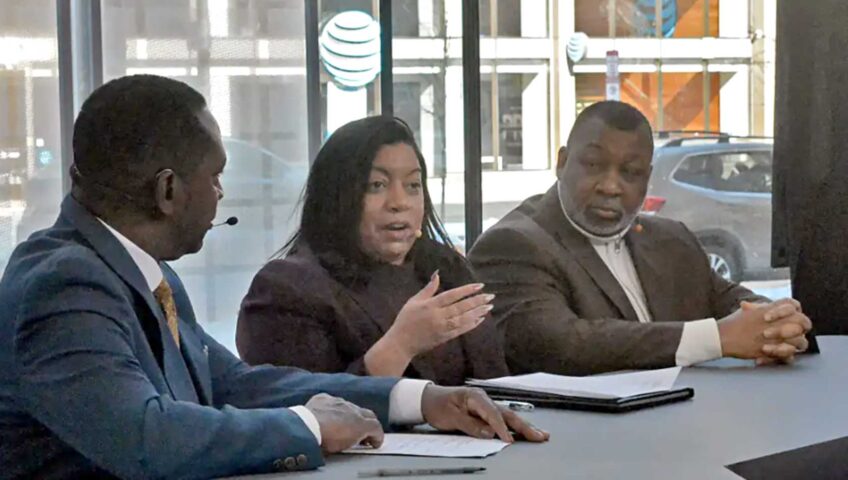Northeastern professors study role of Twitter in Black Lives Matter movement

Within minutes of Michael Brown’s death on August 9, 2014, an African American woman in Ferguson sent out a tweet.
“Ferguson police just executed an unarmed 17 yr old boy that was walking to the store. Shot him 10 times smh [shaking my head],” she wrote under the Twitter handle @AyoMissDarkSkin.
Although she wasn’t a celebrity, journalist, politician or activist, this woman’s account — and others coming from black Ferguson residents on Twitter — played an outsized role in shaping the national conversation around race and police violence following Brown’s death, say Northeastern University’s Sarah J. Jackson and Brooke Foucault Welles.
“This story was told in a particular way, at a particular speed and involved a particular set of diverse perspectives because of Twitter,” said Jackson, an assistant professor of communication studies.
“Violence against African American citizens isn’t new — it’s as old as America is — but who gets to tell the stories is always under contention,” she went on. “Yet we see in this case, the early framing of this story from within the African American community seeped into the way more elite sources later framed the story.”
Jackson and Welles examined more than 500,000 tweets sent in the week after Brown’s death that included the word or hashtag “Ferguson” and analyzed which users were most impactful in shaping the early discussion of the shooting.
They found that many of the most retweeted and mentioned Twitter users were African Americans with connections to Ferguson — while national mainstream news outlets, politicians and celebrities played a lesser role.
Their study, “#Ferguson is everywhere: initiators in emerging counterpublic networks,” was recently published in the journal Information, Communication & Society.
There are a number of reasons diverse voices are amplified more easily on Twitter than in traditional journalism outlets such as newspapers, magazines, television and radio, according to Jackson and Welles.
“The main difference is in who participates,” said Welles, also an assistant professor of communication studies. “Even people who aren’t particularly wealthy can afford the technology, so people can have content-producing devices right in their hands. And the technology itself has integrated several different ways of storytelling — you can have text, images and videos.”
Another reason is that Twitter allows for immediate engagement and critique. “You can speak back to the messages in a way that you can’t in traditional media,” said Jackson.
On the day of Brown’s death, for example, the St. Louis Post Dispatch newspaper reported over Twitter: “Fatal shooting by Ferguson police prompts mob reaction.”
“Immediately, African Americans in St. Louis and Ferguson started doing media criticism,” said Jackson, who noted that blacks use Twitter at a higher rate than the general population. “They said, ‘We have a problem with how this story is being told by this elite news source,’ and their critical comments garnered more retweets.”
One of the most popular responses, she explained, came from St. Louis city alderman Antonio French, who replied, “‘Mob’? You could also use the word ‘community.’”
Although Jackson and Welles can’t say that Twitter alone was responsible for bringing national attention to Michael Brown’s death, they do see the real impact the microblogging social media platform had on the discourse.
“We have a lot of evidence that this story got told in a different way by everyday citizens in Michael Brown’s community on Twitter than it would have gotten told if the St. Louis Post Dispatch was in charge of that story,” said Welles.
“Because of the specific moment where technology was at the time,” added Jackson, “the videos would autoplay and the photos would show up without you having to click through. It absolutely became a moment where it solidified people’s disgust at how these sorts of cases are handled, and perhaps brought more people in from the outside who weren’t thinking about or didn’t have to think about these sorts of issues before.”
But Ferguson wasn’t the first or last time Twitter’s alternative narratives influenced a national discussion. In 2014, Jackson and Welles studied the hashtag “myNYPD,” which the New York Police Department started as a public relations strategy, but quickly turned into a critique about police profiling and stop and frisk. And now they’re turning their attention to the way social media impacted the Baltimore protests in 2015.
“People have figured out a way to make social media work to tell stories from their own perspective,” said Welles, “to change the national conversation — or at least shift the national conversation to include every perspective.”






